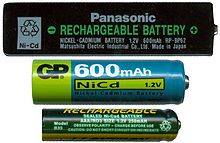Ni-Cd

From top to bottom: "Gumstick", AA, and AAA Ni–Cd batteries
|
|
| Specific energy | 40–60 W·h/kg |
|---|---|
| Energy density | 50–150 W·h/L |
| Specific power | 150 W/kg |
| Charge/discharge efficiency | 70–90% |
| Self-discharge rate | 10%/month |
| Cycle durability | 2,000 cycles |
| Nominal cell voltage | 1.2 V |
The nickel–cadmium battery (NiCd battery or NiCad battery) is a type of rechargeable battery using nickel oxide hydroxide and metallic cadmium as electrodes. The abbreviation NiCd is derived from the chemical symbols of nickel (Ni) and cadmium (Cd): the abbreviation NiCad is a registered trademark of SAFT Corporation, although this brand name is commonly used to describe all Ni–Cd batteries.
Wet-cell nickel-cadmium batteries were invented in 1899. Among rechargeable battery technologies, NiCd rapidly lost market share in the 1990s, to NiMH and Li-ion batteries; market share dropped by 80%. A NiCd battery has a terminal voltage during discharge of around 1.2 volts which decreases little until nearly the end of discharge. NiCd batteries are made in a wide range of sizes and capacities, from portable sealed types interchangeable with carbon-zinc dry cells, to large ventilated cells used for standby power and motive power. Compared with other types of rechargeable cells they offer good cycle life and performance at low temperatures with a fair capacity but their significant advantage is the ability to deliver practically their full rated capacity at high discharge rates (discharging in one hour or less). However, the materials are more costly than that of the lead acid battery, and the cells have high self-discharge rates.
Sealed NiCd cells were at one time widely used in portable power tools, photography equipment, flashlights, emergency lighting, hobby R/C, and portable electronic devices. The superior capacity of the Nickel-metal hydride batteries, and more recently their lower cost, has largely supplanted their use. Further, the environmental impact of the disposal of the toxic metal cadmium has contributed considerably to the reduction in their use. Within the European Union, NiCd batteries can now only be supplied for replacement purposes or for certain types of new equipment such as medical devices.
...
Wikipedia
